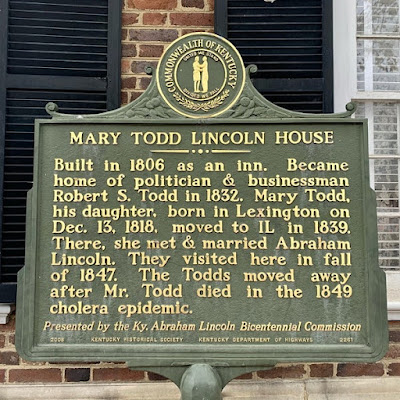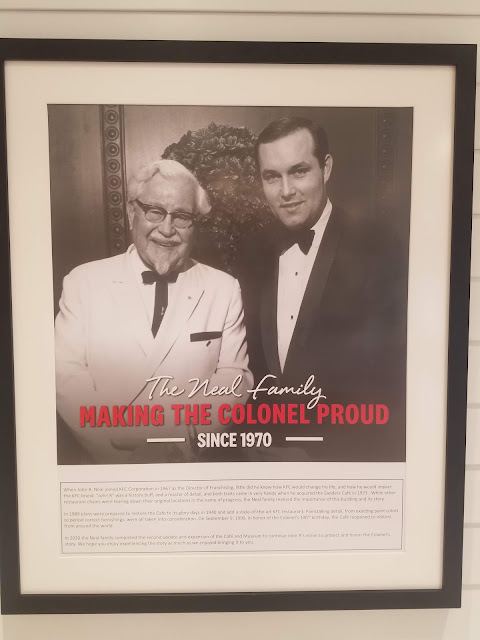Scaled Agile Frameworks - SAFe, SaS, LeSS, etc.
With most organizations practicing some form of agile practice (Kanban, Scrum, Extreme Programming XP, Lean, etc.) at a team level and reaping benefits, organizations are now asking "how can we deploy agile practices to whole departments or at an enterprise level?".
We explore the answer to this by diving into several scaled agile frameworks. These will help organizations in the journey to scale agile practices across departments or across the enterprise.
Introduction
If your organization is considering scaling agile practices within your organization, it is important to understand the differences in the frameworks and the strengths and opportunities posed by each.
Over the past week, I read two (2) articles on scaled agile frameworks. The first article was, “6 Scaled Agile Frameworks – Which One Is Right For You?” by By Marjan Venema. Marjan walked through six (6) scaled agile frameworks and explained the benefits, origins, and opportunities of each. The second article was, “The Ultimate Guide to Scaled Agile Frameworks: SAFe, LeSS, DA, Scrum@Scale” by Maruti Techlabs. Maruti Techlabs article walked through four (4) scaled agile frameworks and provided additional context of each. The Maruti Techlabs article also plugged Maruti Techlabs experience in the space.
Scaled Agile Journey - Mindset and Challenges
Mindset
In the article "6 Scaled Agile Frameworks - Which One is Right for You?", Marjun stresses the importance of the mindset shifts that are needed when scaling agile in the organization. The mindset shift needed is, “letting go of (much of your) control and trusting that everyone wants to perform at their best.”
Marjan pinpoints the mindset shift means the following:
- Decentralizing Decisions
- Building transparency and alignment on strategic goals and how you organize work.
- Determining the right balance between autonomous teams and cross-team dependencies. And having a system in place to manage cross-team dependencies.
- Changing virtually everything in the way you organize work.
- Delivering sooner and perfecting products “in the wild” (in production).
- Collaborating throughout your business and with your customers.
- Updating, replacing, and integrating your information systems to enable transparent information flow throughout your company.
Challenges
Most Organizations run into challenges when scaling agile.
Here are the most common challenges when scaling agile in an organization:
1) Poor or no long-term planning
Long term planning for product roadmaps and product deliveries is important so the agile teams understand the work items which are most important.
It is important for the organization to take ownership and make sure teams are accountable for long term planning.
2.) Delegated Authority Handling
It is important for an organization to get skilled at delegated authority handling. This is needed to minimize disconnects and allow self-directed teams to get in synch with the organizational priorities and business decisions.
3.) Lack of Synchronization
Large-scale organizations have many development teams. Due to the magnitude of teams working in the organization it proves difficult for teams to be entirely self-organized, so it is important to synchronize across the teams in the organization.
It is common for self-organized teams working on similar products to challenge the need for synchronizing deliverables. They are also prone to not wanting to work on delivering them together.
However, it is important to synchronize across teams to minimize duplicate or wasted work, and to minimize disconnects that could impact deliveries to customers.
4.) Lack of Innovation
Large organizations may be stifled in being able to innovate. It is important for large organizations to drive conversations and the necessary actions around innovation. It is important for organizations to celebrate innovation and reward innovation that takes place within the organization.
5.) Culture and Work Management Shift
Agile and Scaled agile is a cultural shift. The Maruti Techlabs article effectively states, “Agile scaling methods require the entire organization to process, act and react differently in every dimension. Unsuccessful shifts to company culture is one of the primary challenges faced by agile transformation failure.”
So, the cultural shift is critical for the success of institutionalizing scaled agile.
One of the most important cultural shifts in the organization is that the culture needs to become value-driven and trust based. The Maruti Techlabs article states it this way, “Value-driven organizations are guided by principles that empower people. To be agile, trust must be built throughout the organization for anything that gives value to customers and facilitates agility throughout the company.”
Maruti Techlabs goes on to say, “Organizations can shift their flow of work in the scaled agile framework by doing the following things:
- Evolve to a more open style of leadership rather than a command and control approach.
- Balance the budget practices from being project-driven to being determined by the value stream.
- Alter the team structure to allow active collaboration and rapid experimentation.
- Modify the communication styles from top-down to more horizontal.
- Update the role of the PMO from the force that dictates how work gets done to the connecting fabric that promotes knowledge across the enterprise.”
6.) Technology Shift
An important ingredient for scaled agile per Maruti Techlabs is, “increased visibility, transparency, and information flow across the organization.”
This means you need to evaluate your technology stack and augment your technology to support scaled agile.
It is important for the technology solutions in the organization to support alignment at a tactical level. Teams cannot successfully scale agile without the right technology and solutions. This is true even when the organizational culture and the workflow are properly aligned.
Organizational Benefits of Scaled Agile
There are a great number of benefits organizations realize when implementing scaled agile. Besides revenue growth and increased profitability, the most common benefits are:
- Better Capacity Management
- Greater alignment of work and the strategy of the business
- Employee Engagement
- Enterprise-Wide Visibility
Simple Guide to Scaled Agile Framework
We review six (6) scaled agile frameworks, provide an executive summary for each, and discuss the main foundational points of each.
The six (6) Scaled Agile Framework approaches covered are:
- SAFe – Scaled Agile Framework
- SaS – Scrum@Scale
- LeSS – Large Scale Scrum
- NEXUS
- DA – Disciplined Agile
- Enterprise Kanban, aka Portfolio Kanban
Before we walk through each approach, it is important to point out that the Scaled Agile Framework (SAFe) is a good method for scaling Scrum in large organizations as it is well documented and more organizations have experimented with this approach to scale their enterprises.
SAFe – Scaled Agile Framework
SAFe is the most widely used scaled agile framework and is well documented. SAFe provides concrete guidance without forcing the organization to immediately rebuild the organizational structure or product architecture.
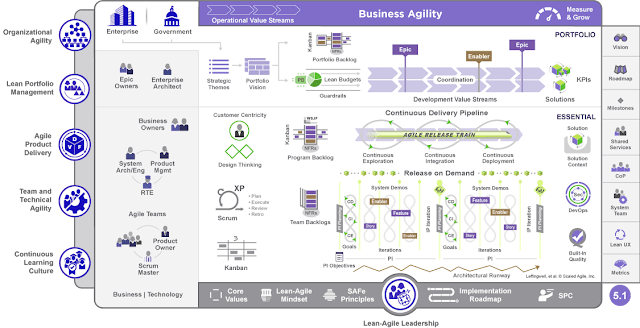 |
| Image courtesy of Scaled Agile, Inc |
An important tool of SAFe is the quarterly planning event “Program Increment Planning” (PI Planning). This is a top-down collaborative planning cycle to feed the standard Scrum Sprint cycles.
SAFe is known as a highly reliable method for outlining the performance / delivery and performs well in organizations with hundreds of teams.
Nexus
This is a scaled agile framework for product delivery.
A Nexus group of 3 to 9 scrum teams is defined with a single product owner and a single product backlog. A Nexus Integration team and Cross-Team Refinement group is assigned to coordinate the work and dependencies between teams.
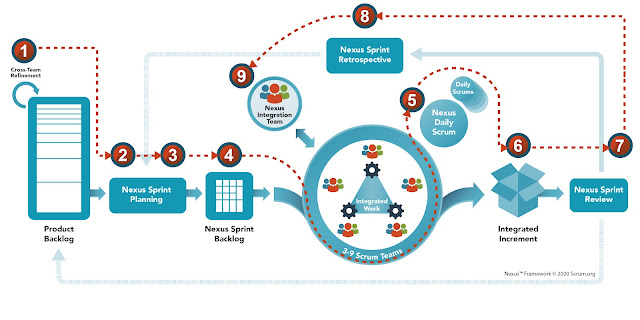 |
| Image courtesy of scrum.org |
The Nexus integration team consists of the product owner, plus a scrum master and members from the development teams. They deal with integration issues so the organization can deliver an integrated product increment.
The Cross-Team refinement is an ongoing activity to surface cross-team dependencies and the teams that will need to work on them.
Scrum@Scale (SaS)
Scrum@Scale is a newer framework so there is not as much information or evidence yet for the framework. The framework was published in 2017 and enables you to scale agile for product delivery.
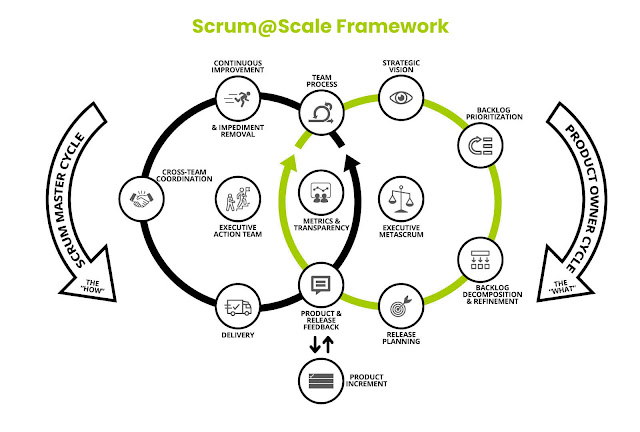 |
| Image courtesy of ScrumAtScale |
Scrum@Scale (SaS) defines two (2) distinct but overlapping cycles: (1) Scrum Master Cycle for product delivery and (2) Product Owner Cycle for product discovery and definition aligned with company’s strategic vision and goals.
SaS defines two (2) new roles. They facilitate scaled versions of Scrum events: the Scrum of Scrums Master and the Chief Product Owner.
Scrum at Scale (SaS) is flexible approach. This is an appealing choice for teams working on a critical product where ample documentation is required for ensuring audibility.
Large Scale Scrum (LeSS)
LeSS is focused on scaling agile for product delivery and is looking to avoid organizational overhead and the need for local optimizations.
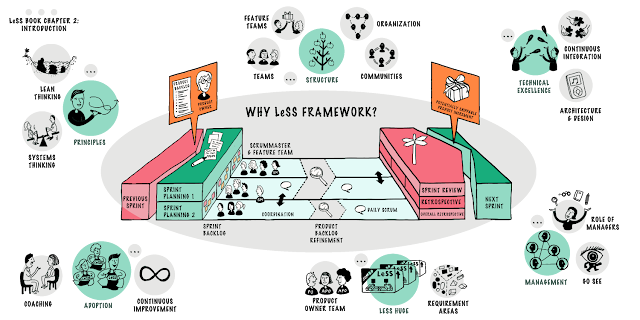 |
| Image courtesy of less.works |
Large Scale Scrum foundation is a single team Scrum and implements very few modifications. LeSS adds an overall retrospective, a preliminary part to the sprint planning, and the per-team sprint review is replaced with an all-teams one.
LeSS is one of the least prescriptive frameworks around.
Disciplined Agile (DA)
Disciplined Agile is more of an assessment based approach to understand how business functions work together and what to address for agile at scale in what is called the Disciplined Agile Enterprise.
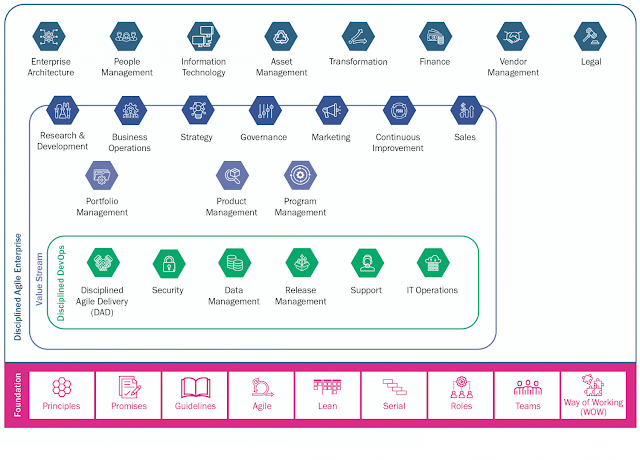 |
| Image Courtesy of pmi.org |
DA is a lightweight framework that identifies the “what” and the tools need but leaves the “how” up to the organization.
DA provides guidance at four levels:
- Foundation – provides insight on principles, promises, lean and agile practices, roles and team structures, and what needed to choose your way of working
- Disciplined DevOps – focusses on integrating security and data management
- Value Streams – helps tie strategies together to improve each part of the business in the context of the whole
- Disciplined Agile Enterprise – guides on creating a structure and culture that embraces change, learning, and innovation.
The DA toolkit is extensive yet DA is lightweight as it doesn’t force you in any particular direction.
Enterprise Kanban, aka Portfolio Kanban
Kanban is about optimizing workflow not about how you structure your organization. The four principles and six practices guide an organization in optimizing workflow, encouraging leadership at every level, focusing on customer needs and expectations, and continual improvement and learning.
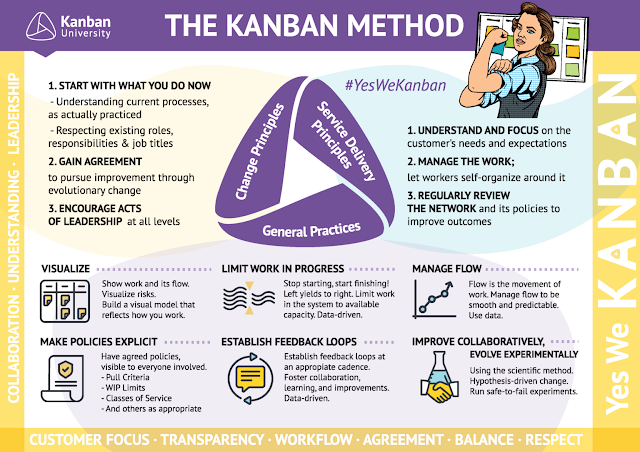 |
| Image Courtesy of kanban.university |
Kanban can be applied to any workflow or value stream, and at any level in the organization or work process. Because of this Kanban is extremely scalable.
Final Thoughts
Each of these scaled agile frameworks is designed to provide the insight and foundation to help an organization scale their agile practices.
If your organization is looking to scale agile to the entire enterprise, then SAFe and Disciplined Agile are the most viable options.
LeSS and Enterprise Kanban are good for organizations that need to run lean or want as little overhead as possible.
If our organization is guided by best practices and you would like to pick the best approaches and tools for each aspect of your organization, Disciplined Agile is a good choice.
Don’t spend too much time trying to pick the perfect option. Experiment with an approach and if it is not working learn and move on to the next best option for your organization. So, get started to start the cultural and mindset shift needed to scale agile within your organization.










